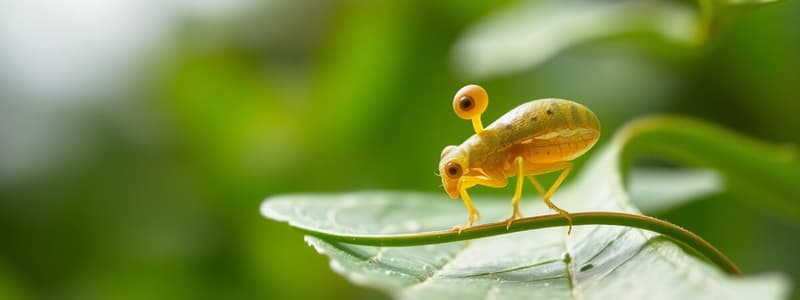Podcast
Questions and Answers
What are the primary sources of evidence for evolution?
What are the primary sources of evidence for evolution?
Fossils, comparative anatomy, and molecular biology.
Define ecology and its key components.
Define ecology and its key components.
Ecology is the study of interactions between organisms and their environment, comprising biotic and abiotic components.
Explain the importance of biodiversity in an ecosystem.
Explain the importance of biodiversity in an ecosystem.
Biodiversity enhances ecosystem resilience and stability, contributing to essential processes like energy flow and nutrient cycling.
What is the role of biotechnology in modern science?
What is the role of biotechnology in modern science?
Describe the process of aerobic respiration and its significance.
Describe the process of aerobic respiration and its significance.
What is biology and why is it considered a multidisciplinary science?
What is biology and why is it considered a multidisciplinary science?
Name and briefly describe two key characteristics of life.
Name and briefly describe two key characteristics of life.
Outline the main steps of the scientific method as applied in biology.
Outline the main steps of the scientific method as applied in biology.
What distinguishes prokaryotic cells from eukaryotic cells?
What distinguishes prokaryotic cells from eukaryotic cells?
How do mutations affect genetic information, and why are they significant?
How do mutations affect genetic information, and why are they significant?
Define evolution and explain its main mechanism.
Define evolution and explain its main mechanism.
What role do organelles play in a eukaryotic cell?
What role do organelles play in a eukaryotic cell?
Explain the processes of transcription and translation in genetics.
Explain the processes of transcription and translation in genetics.
Flashcards
What is biology?
What is biology?
The study of life and living organisms, encompassing their structure, function, growth, origin, evolution, and distribution.
What is a cell?
What is a cell?
The basic unit of life, which can be prokaryotic (lacking a nucleus and membrane-bound organelles) or eukaryotic (containing a nucleus and membrane-bound organelles).
What is homeostasis?
What is homeostasis?
A process where organisms maintain a stable internal environment, despite changes in their surroundings. Think of it as maintaining a consistent temperature, water balance, or nutrient levels.
What is evolution?
What is evolution?
Signup and view all the flashcards
What is the scientific method?
What is the scientific method?
Signup and view all the flashcards
What is genetics?
What is genetics?
Signup and view all the flashcards
What are genes?
What are genes?
Signup and view all the flashcards
What is reproduction?
What is reproduction?
Signup and view all the flashcards
Define Biodiversity
Define Biodiversity
Signup and view all the flashcards
What is Taxonomy?
What is Taxonomy?
Signup and view all the flashcards
What is Cellular Respiration?
What is Cellular Respiration?
Signup and view all the flashcards
Describe Biomedical Science
Describe Biomedical Science
Signup and view all the flashcards
Study Notes
Introduction to Biology
- Biology is the study of life and living organisms.
- It encompasses a vast range of topics, including the structure, function, growth, origin, evolution, and distribution of living things.
- Biology is a multidisciplinary science, drawing on principles from chemistry, physics, and mathematics.
- Branches of biology include botany, zoology, microbiology, genetics, and ecology.
Key Characteristics of Life
- Organisms are composed of cells, the basic unit of life.
- Organisms exhibit organization, from the cellular level to complex organ systems.
- Organisms maintain homeostasis, a stable internal environment.
- Organisms grow and develop throughout their lifespans.
- Organisms respond to stimuli in their environment.
- Organisms reproduce, creating new individuals of the same kind.
- Organisms adapt to their environment through evolution over generations.
- Organisms use energy to power their activities.
The Scientific Method in Biology
- The scientific method is a systematic approach to understanding the natural world.
- It involves observation, hypothesis formation, experimentation, data analysis, and conclusion drawing.
- Hypotheses are testable explanations of phenomena.
- Experiments are designed to test hypotheses, with variables carefully controlled.
- Data analysis involves interpreting results in light of the hypothesis.
- Conclusions can support or reject a hypothesis, leading to further research.
Basic Cellular Biology
- Cells are the fundamental units of life and can be prokaryotic or eukaryotic.
- Prokaryotic cells are typically smaller and lack membrane-bound organelles.
- Eukaryotic cells are larger and have membrane-bound organelles, including a nucleus.
- Cell membranes regulate the flow of materials into and out of the cell.
- Organelles each carry out specific functions within the cell.
Genetics
- Genetics is the study of genes, heredity, and variation.
- Genes are segments of DNA that code for specific traits.
- DNA carries the genetic information of an organism.
- DNA replication is the process of making a copy of DNA.
- Transcription is the process of making RNA from DNA.
- Translation is the process of making protein from RNA.
- Mutations are changes in the DNA sequence.
Evolution
- Evolution is the change in the heritable characteristics of biological populations over successive generations.
- Natural selection is a key mechanism of evolution.
- Evolution accounts for the diversity of life on Earth.
- Evidence for evolution comes from fossils, comparative anatomy, and molecular biology.
Ecology
- Ecology is the study of the interactions between organisms and their environment.
- Ecosystems are comprised of biotic (living) and abiotic (non-living) components.
- Ecology examines relationships like predation, competition, and symbiosis.
- Energy flow and nutrient cycling are crucial aspects of ecological systems.
- Biodiversity is the variety of life in a particular habitat or region.
Other Significant Biological Concepts
- Taxonomy is the science of classifying organisms.
- The classification system commonly used is based on shared characteristics and evolutionary relationships.
- Organisms are grouped into hierarchical categories, from domain to species.
- Biotechnology involves manipulating living organisms or their components to develop new products or technologies.
- Modern biotechnology utilizes genetic engineering to modify organisms.
Biomedical Science
- Biomedical science integrates biology and medicine.
- It focuses on areas like human physiology, disease mechanisms, and treatment development.
- This field contributes to the understanding and treatment of human health issues.
Biological Molecules
- Biological systems are composed of many macromolecules.
- Key molecules include carbohydrates, lipids, proteins, and nucleic acids, each with crucial functions.
Cell Respiration
- Cell respiration is the process by which cells release energy from glucose.
- It involves a series of chemical reactions to produce ATP.
- Aerobic respiration requires oxygen to produce the most ATP.
Studying That Suits You
Use AI to generate personalized quizzes and flashcards to suit your learning preferences.



